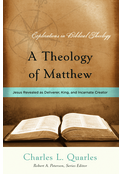Dr. Charles L. Quarles is Professor of New Testament and Biblical Theology at Southeastern Baptist Theological Seminary. We found his recent A Theology of Matthew (P&R, 2013) a delightful read on several levels. Its insightful Biblical-Theological connections, its refreshingly relentless and enlightening portrayal of Jesus, its warmth, its accessibility, and its concise presentation of so much material all combine to give it high marks. The help Quarles provides here regarding the large structures of Matthew’s thought will be a welcome aid to any preacher working his way through the first Gospel. We are pleased that he has agreed to speak to our readers here at Books At a Glance.
Books At a Glance (Fred Zaspel):
First, can you tell us something of how this book came about? Has the Gospel of Matthew long been an area of particular interest and study for you?
Quarles:
Yes. I wrote my dissertation on the historical reliability of the accounts of Jesus’ birth in Matthew and Luke. I later wrote the Study Notes on Matthew for the Holman Christian Standard Study Bible. Several years ago I wrote a commentary on the Sermon on the Mount. I am now working on two other commentaries on Matthew. The wall of my office is adorned by a large print of Guido Reni’s “Saint Matthew and the Angel.” Studying Matthew is one of my passions.
Books At a Glance:
We’re curious about the ordering of the material in your book — first Jesus as the new Moses, then as the new David, then as the new Abraham, and then as the new Creator. Some of this could seem backwards! What considerations led you to approach these themes in this order?
Quarles:
I wrestled with the order of topics for a while. All along I wanted the book to climax with the New Creator theme. I am grieved by the modern church’s neglect of the great doctrine of Jesus’ deity, a doctrine that becomes more and more precious to me. Originally, I treated the new David and new Abraham themes before the new Moses theme because those two themes are prominent even in the very first verse of the Gospel. I ultimately adopted the present order because the new Moses theme is so closely tied to soteriology.
 Books At a Glance:
Books At a Glance:
Please explain what you mean by a “vertical” and “horizontal” reading of Matthew and what insights these approaches may provide.
Quarles:
When my students ask this question, I explain with as straight a face as possible that these approaches refer to reading the Gospels while either standing or reclining. But actually, by “vertical reading” I mean reading the Gospel from beginning to end, with as few interruptions as possible. Too often we read the Gospels in piecemeal fashion and miss out on important connections between one episode and another. A good “vertical reading” remedies this. I have a strong suspicion that this is the manner in which Matthew expected the reader to approach his text. After all, the Gospel of Matthew is a real “page-turner.” The events and teachings that it records are so fascinating and gripping that the one who reads it with an open heart will find it hard to put down.
Horizontal reading involves careful comparison of the parallel accounts in the Gospels that highlights the theological emphases of the Gospel writers. Although the Gospel accounts never disagree with each other, they are different from one another in subtle ways. These subtle differences often shed light on the Gospel writer’s theological themes.
Books At a Glance:
In Matthew 13:52 Jesus says, “Therefore every scribe who has been trained for the kingdom of heaven is like a master of a house, who brings out of his treasure what is new and what is old.” How might this shed light on Matthew’s purpose in writing his Gospel?
Quarles:
Like many Matthean scholars, I believe that the statement is at least partially autobiographical. Matthew serves as the kingdom scribe bringing the new and old out of his treasure chest. The “old” refers to the prophecies and pictures of Christ in the Old Testament. The “new” refers to Jesus’ teaching about himself and his kingdom. The clearest examples of this theological strategy are the fulfillment citations of the Gospel.
Books At a Glance:
Your book focuses on the large themes of Moses, David, Abraham, and Creator. Were there any lesser themes in the Gospel of Matthew that you would like to have pursued, or perhaps that are in the plans?
Quarles:
Yes, the final version of the book is about half the size of the original version! Originally I had much more extensive discussions of Old Testament messianic prophecies and how Jesus fulfilled them. I also had a fairly extensive treatment of Jesus’ kingdom parables. However, reducing the size of the book made it a much more convenient tool for busy pastors.
This book focuses mainly on Matthew’s Christology but also treats topics like soteriology, ecclesiology, and eschatology. Matthew’s theology was highly integrated. His view of Christ shapes his view of everything else. For example, his presentation of Jesus as the new Moses is related to his teaching that Jesus delivers his followers from their slavery to sin (new Exodus), transforms them from the inside out (new covenant), and is Isaiah’s Suffering Servant who suffered the punishment for our sins in our place (substitutionary atonement). Matthew did not regard Christology as a separate and distinct category that can be neatly isolated from other doctrines. His other doctrinal teachings flow from his exalted view of Jesus.
Books At a Glance:
Given this variety of Matthew’s themes and sub-themes, how might you characterize Matthew’s overall purpose in writing? Or perhaps better, what is his single, over-arching theme that captures and explains all these others? If we were to ask Matthew why he wrote, how do you think he would respond?
Quarles:
Matthew wrote to show that Jesus is the fulfillment of the Old Testament. All its prophecies and promises find their fulfillment in him. All its hopes and longings find their satisfaction in him.
Books At a Glance:
In light of all this, and perhaps some related considerations, what counsel can you give pastors who are preaching their way through the first Gospel?
Quarles:
A faithful and accurate message from the Gospel of Matthew must exalt Christ and prompt hearers to worship and adore him. Understand and highlight at least one of Matthew’s great Christological themes in every sermon. Don’t fall into the trap of emphasizing “practical truths” to the neglect of doctrinal truths. Properly understood, nothing is more practical than sound Bible doctrine.
In the book I give some frightening data based on years of research that shows that people today often attend church each week for years, even decades, without ever understanding such fundamental truths as Jesus’ deity and bodily resurrection. Yet the New Testament is clear that these truths are absolutely essential to salvation and necessary affirmations of true Christianity (Rom. 10:9). It is critical that the church recover sound expository preaching with both a doctrinal and practical emphasis.
Books At a Glance:
Do you have plans to write another book like this for any of the other three Gospels?
Quarles:
That’s something that I would seriously consider if given the opportunity. My next book is an introduction to Paul’s life, letters, and theology. It is scheduled to appear this summer. Then I have a couple of commentaries to write on Matthew.
Books At a Glance:
Congratulations and thank you for your helpful book. And thanks for talking to our readers!
Buy the books

A THEOLOGY OF MATTHEW
